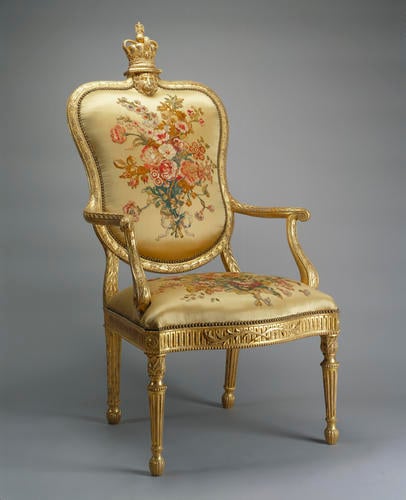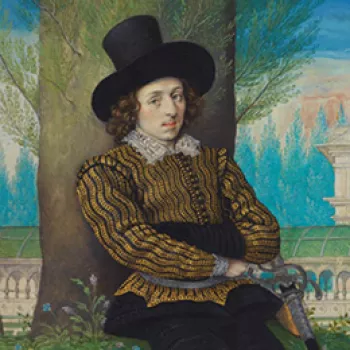A Pair of Armchairs c.1780
Gilded beechwood, upholstered in embroidered silk and wool | 153.0 x 74.0 x 83.0 cm (whole object) | RCIN 1141
-
Carved gilt wood open armchairs with upholstered backs and seats. The back is shaped and has a stylised laurel wreath and berry motif edge, topped by a crown above a lion mask. The arms rest on S-shaped supports. A fluted frieze covers three sides of the frame and straight carved legs. This piece is one component of a complete suite containing two armchairs and ten stools.
The modernisation of the State Apartments at Windsor Castle c.1778-95 for George III and Queen Charlotte under the supervision of Sir William Chambers’s assistant John Yenn is poorly documented and now largely forgotten. It was also short-lived, being overtaken first by James Wyatt’s Gothic work in the first years of the nineteenth century and then almost entirely obliterated by Sir Jeffry Wyatville in the remodelling of the 1820s and 1830s for George IV and William IV. Nevertheless, during this period significant changes to the decoration and furnishing of the King’s and Queen’s Apartments were introduced, notably in the King’s Audience Chamber and in Queen Charlotte’s State Bedroom (now part of the Royal Library). Unusually, Pyne records the names of some of the craftsmen involved in the Audience Chamber. Robert Campbell was responsible for the King’s throne, while the remarkable flower-embroidered hangings of the throne canopy were designed by the celebrated flower painter and founder-member of the Royal Academy, Mary Moser; these hangings were still in place at the time of Wild’s view of the room in 1818 . They were worked by Mrs Pawsey of Great Newport Street, whose premises were adjacent to Campbell’s and who had in 1778 taken over from her aunt Mrs Phoebe Wright the Royal School for Embroidering Females. This establishment, which was actively supported by the Queen, was intended for the orphaned or impoverished daughters of professional men. After 1809 it transferred from London to Ampthill, Bedfordshire.
In the same year (1778), Queen Charlotte had installed in her State Bedchamber a magnificent new canopied bed in the neo-classical style, possibly designed by Yenn. The hangings, like those of the King’s throne canopy, were decorated with richly coloured and botanically accurate floral needlework embroidered by the pupils of Mrs Wright’s school in 1772-7 and very probably to her designs. Accompanying the bed, which is now at Hampton Court, were two armchairs and ten stools upholstered en suite, all originally finished in three colours of gold. This suite is similar in character - although more grandly detailed and expensively decorated - to the armchairs and stools supplied, perhaps later in the 1780s, for the King’s State Apartments. All are likely to have been made by Campbell, who later described his firm as ‘Upholsterers to Their Majesties’ (but never held an official warrant). Campbell’s association with this project continued until at least 1794-5, when he supplied the mirror glass for four new oval pier glasses for the King’s State Apartment, designed by John Yenn and carved by Richard Lawrence. One of the chairs is inscribed on the calico beneath the embroidered covers with the name of the workman responsible for the upholstery, James M. Brown(?) of Windsor and the date 21 July 1780.
The stitching used in late eighteenth-century embroidery of this type had progressed from that used in seventeenth- and early eighteenth-century floral embroidery, which had largely consisted of tapestry depictions of flowers in vases, worked in tent or cross stitch. In these earlier models the flowers themselves, although identifiable, are amateur and flat compared with the creations of the later eighteenth century. In part, this was explained by tent or cross stitch giving way to simpler long stitches, where the accuracy and tension of every stitch did not have to be maintained so thoroughly. These simpler, long stitch lines were more suited to the lighter upholstery fabrics that giltwood furniture demanded, and they also gave a more painterly effect.
Catalogue entry adapted from George III & Queen Charlotte: Patronage, Collecting and Court Taste, London, 2004 and Painting Paradise: The Art of the Garden, London, 2015.Provenance
Made for Queen Charlotte.
-
Creator(s)
(upholsterer)(embroiderer)(nationality) -
Medium and techniques
Gilded beechwood, upholstered in embroidered silk and wool
Measurements
153.0 x 74.0 x 83.0 cm (whole object)
Category
Object type(s)









